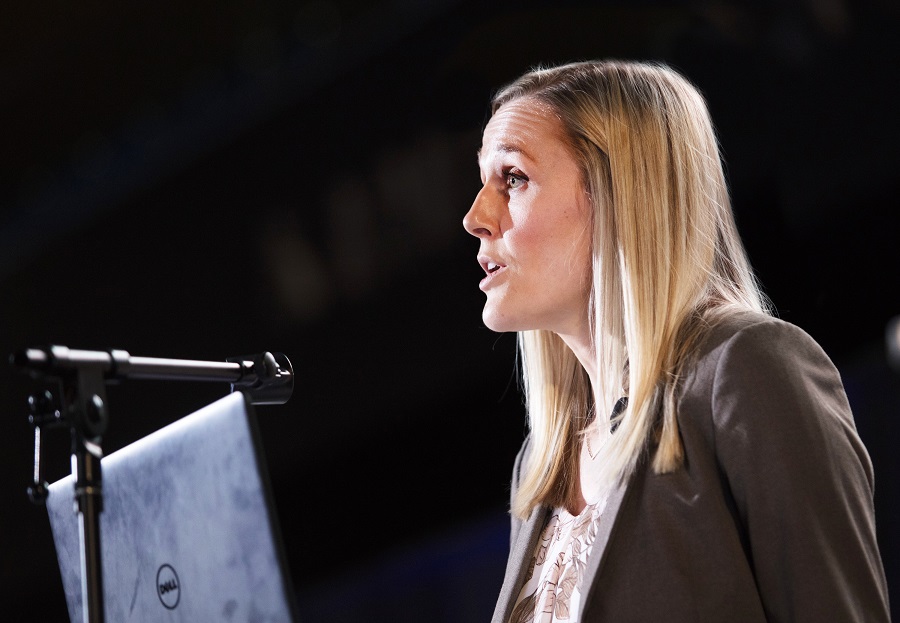The Faculty of Kinesiology and Physical Education hosted another successful public symposium on March 5 turning the lens on how exercise can optimize nutrition. Moderated by nutrition expert and celebrity trainer Harley Pasternak, the symposium heard from new faculty member, Assistant Professor Jenna Gillen, Assistant Professor Daniel Moore and registered dietitian and sport nutritionist Jennifer Sygo.

Assistant Professor Daniel Moore takes a question from the audience at the 2019 KPE public symposium on optimizing nutrition through exercise
“The muscles in our bodies are built of proteins that are composed of individual building blocks called amino acids. These muscle proteins are very dynamic and are constantly ‘turning over’, which means old or damaged ones are broken down into amino acids and new ones remade in their place,” said Moore.
“Any time we eat a meal containing protein we can speed up the rate at which we are building new muscle proteins by providing the muscle with new amino acid building blocks. This allows us to maintain the quality of the proteins in our muscles or, if we are performing exercise such as lifting weights, to grow our muscles,” he said.
The trouble comes when our muscles are under-used, because they become less sensitive to the protein that we eat and cannot use the amino acids as efficiently to rebuild themselves. This is commonly referred to as anabolic resistance and when not corrected can lead to a loss of muscle over time.
“Anabolic resistance is one of the main causes of muscle loss with extreme inactivity, such as bed rest or wearing a cast, and even more ‘benign’ forms of inactivity such as leading a sedentary lifestyle,” said Moore.
The good news is that by focusing on how much protein we consume in each meal of the day and how active our muscles are before we eat those meals, we can improve the efficiency with which our muscles use the protein in our diets in order to maintain an optimal quantity and quality of this important tissue across the lifespan.
"Evenly spacing out the protein you consume throughout the day increases muscle synthesis compared to low protein breakfast and high protein dinner," said Moore.

Assistant Professor Jenna Gillen presenting at the 2019 KPE public symposium
Gillen’s talk focused on how physical activity makes controlling our blood sugar easier.
“Carbohydrates are made up of sugars that provide our bodies with an important source of energy. When we consume carbohydrates our blood sugar levels rise, which can be taken up and used by different tissues in the body,” said Gillen. “Muscle is one of the most important tissues that consumes blood sugar, using it for energy, which helps bring blood sugar levels back down.”
However, when muscle is less active, such as during a day of sitting or months of not performing physical activity, it needs less energy and can become less sensitive to rises in blood sugar. This can result in blood sugar levels staying high, which overtime, increases the risk for metabolic diseases such as type 2 diabetes. Fortunately, becoming more physically active can increase muscle’s need and ability to consume sugar, which helps reduce high blood sugar levels.
“For example, breaking up prolonged periods of sitting with short (< 5min) repeated exercise “snacks” can lower blood sugar throughout the day. Similarly, performing one structured exercise session after a meal can immediately lower the rise in blood sugar from breakfast, lunch or dinner,” said Gillen.
Best of all, once regular exercise becomes a normal part of your weekly routine, muscle becomes more sensitive to blood sugar and is capable of consuming more even on days that exercise isn’t performed.

Nutritionist and dietitian Jennifer Sygo closed off the presentations at the 2019 KPE public symposium
Sygo talked about the energy and nutrient needs for competitive and high performance athletes, highlighting how they may differ from the general population, specifically in terms of carbohydrate intake.
“At low-to-moderate levels of activity, the relationship between exercise and appetite tends to be tightly controlled, which means that increasing activity can lead to increased hunger. For highly active individuals, including competitive or high performance athletes, energy needs can be substantially elevated and appetite may become uncoupled from activity level,” said Sygo, whose expertise in nutrition has been sought by Toronto Raptors to boost their performance.
“The result is that high performance athletes often need to emphasize high-calorie foods and, in some cases, must intentionally limit filling up on lower calorie foods, such as fruits and vegetables that could prevent them from meeting their energy needs.”
The video of the event has been posted online for those who weren't able to attend.
Optimizing Nutrition Through Exercise was hosted and presented by the Faculty of Kinesiology and Physical Education at the University of Toronto and sponsored by Iovate Health Sciences, the makers of MuscleTech.
